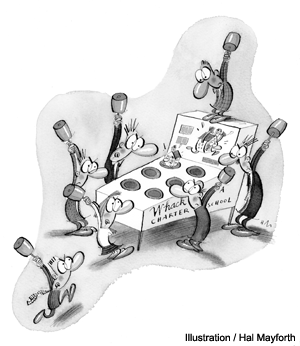How is it that a system can simultaneously master the art of resisting reform and stick to the path of least resistance? Such is the conundrum facing public education.
That our schools are impervious to fundamental change (fads-of-the-month notwithstanding) is well established. Joe Williams (“Games Charter Opponents Play”) recounts the imaginative means school districts find to strangle promising reforms, in this case charter schools. Couldn’t defeat them in the legislature? Then bleed them with a thousand little cuts. Can’t halt them with a state-mandated cap? File a frivolous lawsuit. Can’t persuade parents that they aren’t worth choosing? Ground their buses so students can’t get to the schools. Though twisted, many of these actions are inventive and energetic, some even entrepreneurial.
But push the education system to address its own widespread failures and suddenly it becomes limper than a lunchroom Tater Tot. Consider teacher quality. Virtually every school district in the nation possesses the authority to fire ineffective teachers within their first year or two on the job, without much difficulty. As Thomas Kane and his colleagues argue (“Photo Finish”), the effectiveness of a teacher can be predicted early on. Letting the weakest ones go makes perfect sense and requires no change in law or collective bargaining agreements. Why, then, don’t districts routinely dismiss those rookie teachers who don’t have the right stuff? Secure on the path of least resistance, administrators typically find it is just too much work to fire someone and find a replacement. Instead, they keep them all—good, bad, and indifferent. Later on, their hands are tied. They’re “stuck” with poor performers.
Consider the fate of failing schools under the No Child Left Behind Act. While the law’s rhetoric is John Wayne tough, its reality is Tiny Tim timid. Districts are expected to “restructure” their chronically low-performing schools by firing the entire staff, reopening as a charter school, or contracting with private managers. Most instead opt for soft reforms like sending in an instructional “coach” or tweaking the curriculum. As both Sara Mead and Nelson Smith lament, it’s a tragic lost opportunity. How to explain districts’ actions? They’re on the path of least resistance. It’s just too hard to close down a school and launch a “fresh start.”
To be sure, such bumbling behavior has long been associated with bureaucracies. Shielded from the free market’s incentives, public sector officials learn to “make nice” rather than make unpopular decisions. But in K–12 education, “accountability” was supposed to change all that. The new system of rewards for strong performance and tough sanctions for failure was meant to motivate officials to do the difficult work, make the hard choices, upset the applecart.
So why isn’t it working? Why don’t newly accountable principals, driven to raise student achievement, dismiss their ineffective rookie teachers? Why don’t newly accountable superintendents, committed to “leaving no child behind,” shut down their failing schools? Why hasn’t accountability closed off the path of least resistance?
There are two obvious explanations. First, accountability as we know it is still too weak-kneed. Sure, there’s plenty of sunlight and shame, with schools labeled “in need of improvement” and editorial writers wringing their hands. Yet very few public school employees—from the superintendent to the soup server—ever lose their jobs for poor performance. We need more head rolling, and less eye rolling.
Second, accountability is not enough. Competition via school choice is the other weapon in the “tough love” arsenal, and until it’s wielded at large scale, we are unlikely to see real results.
Which brings us back to charter schools. Through the eyes of change-resistant bureaucrats, they present a mortal threat to the very culture of the public education system. Were they to grab significant market share, they might “tip” K–12 education into an age of real accountability. And that’s a path the system can be expected to blockade with all the entrepreneurial zest it can muster. One only wishes all that energy could be put to a better purpose.



